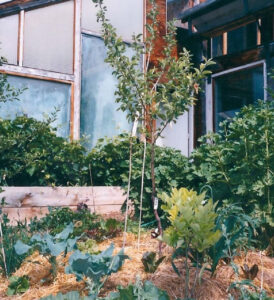Climate Change and Perennial Fruit and Nut Production: Investing in Resilience in Uncertain Times
By Guy K. Ames and Rex Dufour, NCAT Agriculture Specialists
Abstract
This publication explores climate-related challenges to perennial fruit and nut production, including drought, frost, flooding, and extreme weather events. It discusses steps growers can take to build resilience into their farming operations through diversification, water stewardship, and soil building, as well as technology, information, and policy.
Table of Contents
Introduction
What Are Current Challenges?
Building Resilience in Uncertain Times
Conclusion
References
Introduction
Record-breaking heat waves, long-term drought, “once every 500 years” floods in back-to-back years, and other extreme manifestations of an apparently changing climate challenge all of American agriculture, but perennial fruit and nut crops are especially threatened.
Because of its long-lived nature, including two, three, or more years of plant growth before bearing a crop, perennial fruit and nut production requires a long-term commitment from farmers. Many fruit and nut crops do not provide a return on investment until several years after planting. If bloom times, frost dates, chilling hours, plant stress, disease incidence, and insect pressure are made uncertain by an unpredictable climate, growers of perennial fruit and nut crops will find it increasingly difficult to stay in business. Wheat or corn growers can decide from year-to-year whether to plant a little late or plant a little early or plant a different variety. But fruit growers can be locked in for decades once they’ve made a decision.
“Climate change is expected to alter the global industry in fruits and nuts dramatically as tree crops such as pistachios and cherries struggle in the rising temperatures. Even if polluters take greater action to cut carbon emissions, the impact of climate change will likely be severe enough that the nearly $100 billion-a-year fruit and nut industry needs to reassess planning.” (Luedeling et al., 2011).
There is no panacea, of course, for something so uncertain. Yet, many growers and researchers are thinking about, talking about, and making plans to increase resilience in these perennial systems in the face of climate change.
What Are Current Challenges?
“The principal impacts of projected climate change are more likely to result from changes in the frequency of threshold events and extremes, such as the date of last spring freeze, the length of the growing season, and heat accumulation, than from changes in mean climatic states.” (Winkler et al., 2011) In other words, the one-to-four-degree average increase in global temperature will not itself be the problem. The problems will be extreme events—such as storms, droughts, killing frosts, and changes in the length of the growing season—that have the temperature increase as their root cause.
Drought
Drought has an impact on both annual and perennial crops, but perennial crops, in general, use more water simply by virtue of being in place longer. For example, almond trees have to be kept alive even after their nuts have been harvested, so that they can bear a crop of nuts the following year. In contrast, annual crops can be started anew each year and, after harvest, irrigation can stop until the next planting.
At this writing, California, the U.S. produce basket, is facing an extreme multi-year drought. California produces roughly 50% of the nation’s fruits and vegetables (with another 30% coming from drought-stressed parts of Mexico) and near 100% of the nation’s apricots, almonds, pistachios, and walnuts. In California, water is being apportioned according to politics (cities have more people than agricultural areas), laws (many of them antiquated), and sometimes logic. Regarding this last factor—logic—it makes good sense to keep the perennial crops alive because there is a multi-year investment at the front end before they start producing food, and because the return on the dollar is much greater (as much as ten times greater).
Historically, in the arid West, where on-farm water (from wells, streams, or ponds) was unavailable, water has been delivered to fruit growers via an elaborate and federally funded system of reservoirs, aqueducts, and allotments. The water itself is almost all from snowmelt in adjacent mountains, as is the water in rivers and other streams. When snowfall is short in any given year, rivers and reservoirs that are dependent on snowmelt shrink, limiting availability of irrigation water for farmers far from the mountains. In some areas of the West, orchardists have compensated for unreliable snowmelt by tapping into groundwater with deep wells, but this water supply is itself receding and is often suffering from salinization due to decades of agricultural activity.
As just one example of crop water-dependence, California almonds drink an estimated 1.1 trillion gallons of water per year. In 2013, there were 940,000 acres of almonds in California, according to the USDA’s California Almond Acreage Report (2013). Each acre of almonds uses three to four acre-feet of water each year, practically all supplied by artificial irrigation (well water or snowmelt). An acre-foot is the amount of water needed to cover an acre of ground one foot deep, or about 325,000 gallons of water. With this single example it’s easy to see how California agriculture uses roughly 80% of all irrigation water, nationally. If the current “exceptional” drought continues and water must be apportioned to cities or rural acreage, cities will get it.
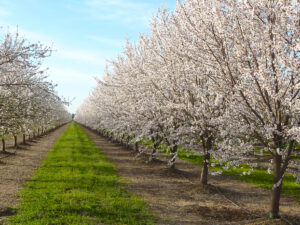
California almond orchard in bloom. Photo: Rex Dufour, NCAT
B. Lynn Ingram, a paleoclimatologist at the University of California-Berkeley and author of The West Without Water, says the 20th century was a rain-soaked anomaly compared to that region’s long-term history. If California reverts to its drier norm, farmers could expect an average of 15% less precipitation in the coming decades. Wells won’t save the state, either, says Ingram: Farmers are already pumping the groundwater that lies deep under their farms much faster than it can be naturally recharged (Philpott, 2014).
Even in the fruit growing regions of the East, where rain can supply much of the necessary water, recent droughts have stretched the resources of fruit growers. Moreover, the timing of rains can be crucial. Rain is necessary for early spring growth of trees, bud set (most tree fruits set buds for the following year’s crop in or around June, and conditions must be good for that bud set to occur), and fruit growth itself. Too little water at any of those times can stress trees and reduce the value of the crop.
And, of course, drought isn’t limited to California. Commercial plantings of pecans in Arizona, Texas, Oklahoma, and the Southeast are vulnerable, as are grape and berry crops. In the upper Midwest and Northeast, droughts are not predicted to be as bad as elsewhere in the country, but growers should not fail to plan for them.
An analysis of the effects of global warming on water supply and demand found that more than 1,100 counties — one-third of all counties in the lower 48 states — will face higher risks of water shortages by mid-century as the result of global warming. More than 400 of these counties will face extremely high risks of water shortages (Roy et al., 2012).
Even areas of the country like the Gulf states, where rain has historically been adequate for crop production, are experiencing seasonal shortages. Used to be, you could count on rain in Mississippi. Now, you would be a fool not to have irrigation. It’s not that we don’t have rain; it’s the amount at a time and the frequency that have changed. Even 10 or 15 years ago, in June and July, you could almost set your watch by the afternoon rains every day. The summer pattern was for warm, moist Gulf breezes to build moisture in the atmosphere that would provide gentle rains (pop-up storms) during the heat of the day. That’s not so anymore. We might have a week of heavy rains; we might have two weeks without a drop. That’s just the way it is now. (Ewing, 2014)
The U.S. Environmental Protection Agency acknowledges that the Southeast has been affected by climate change over the course of the past century, with increases in both in the incidence of heavy downpours and the extent of spring and summer drought (U.S. EPA, 2013).
Lastly, drought can exacerbate other problems. For instance, drought stress predisposes apple trees to damage from trunk borers. And squirrels and other vertebrates looking for acorns and hickory nuts will quickly turn to any available food source if the mast is in short supply due to adverse weather events. Coyotes (and probably other animals) looking for water have been known to damage drip irrigation lines during drought periods, and farmers report increased bird damage to fruit during extended droughts.
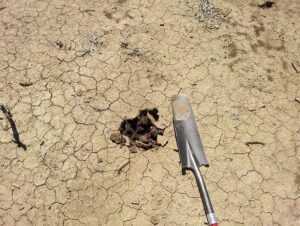
Soil crusting in a California walnut orchard due to fl ooding and poor organic matter content. Photo: Rex Dufour, NCAT
Flooding
While California and the Southwest are drying up, the Northeast has experienced several record-breaking floods; at least two from hurricanes that pushed far inland. Likewise, floods in the Midwest and Southeast during the past decade have made history. And even in the West and Southwest, when rain does come, it often comes in deluges. Cornell University warns that more precipitation is occurring in the form of heavy rainfall events (more than two inches in 48 hours), and this trend is expected to continue (Wolfe, 2011). Flooding’s deleterious effects include the following:
- Root damage and reduced yield
- Soil compaction from use of heavy machinery on wet soils
- Soil loss from erosion during heavy rain events
- Contamination of waterways from agricultural runoff
- Soil crusting
Frost
Most temperate-zone fruit and nut trees bloom in the spring and ripen their fruit throughout the remainder of the growing season. And most fruit and nut crops are threatened every spring by freezing temperatures during their bloom period. Of the major fruit crops, stone fruits (e.g., almonds, peaches, plums, cherries, and apricots) are the worst for this and already are grown reliably in only a few parts of the country. A change in the bloom time or frost date could render an already-risky crop commercially nonviable.
And, indeed, this is what appears to be happening worldwide. Researchers in Iran, South Africa, and California have determined that warmer temperatures overall have led to earlier flowering, but that frost dates are still roughly the same. The result is that trees are more likely to be in bloom when killing frosts occur.
“The layman’s assumption is that as temperatures get warmer, there will be less frost. But although the severity of the frost has decreased, the last day of frost hasn’t been receding as quickly as the advances in flowering. The result is that frost events are increasingly taking place during flowering and damaging the flowers. No flowers equals no fruit,” says climatologist Jennifer Fitchett (2014).
In Michigan:
From apples to blueberries, early growth stages that normally occur during April and early May are all over the place. The current warm spell has advanced the growing season by more than three weeks in our major fruit crops, blueberries, apples, and cherries. For blueberries, the “tight cluster” growth stage occurred in 2010 around April 28 in the variety Bluecrop. As of March 22, the same stage in the same variety is all over the fields in west Michigan. That is one month in advance. The same can be said for the other fruit crops. (Garcia-Salazar, 2012)
Chilling Hours
Trees in temperate regions need a chilling period so they can grow and fruit in the spring. Rising temperatures pose a special problem for temperate but comparatively warm areas where adequate winter chill is already in short supply. Fruit and nut trees are predicted to be highly affected in California, the southeastern United States, China’s Yunnan province, and southern and southwestern Australia (Luedeling, 2011).
Cherries in California are one of the affected crops. “Bad years are becoming more common in California, thanks to climate change. There’s always crop insurance, but [Lodi cherry farmer Jeff Columbini] says he’s heard rumors that some growers in the southern part of the San Joaquin Valley are getting frustrated with the spotty harvests, and pulling up their cherry trees. There are varieties that don’t require as much winter chill, but they all require some chill.” (Myrow, 2014).
Murray Family Farms in Arvin, southeast of Bakersfield, is not pulling up any trees, yet, even though “it’s pretty terrible.” Ashlee Beason is the farm’s farmers market director and store supervisor. She says Murray grows 27 varieties and, this year, only 12 bore fruit. “We didn’t get our chill hours this year. Early varieties came in at 50%. The later varieties didn’t come in at all.” (Myrow, 2014).
Heat
Periods of unrelenting summer heat characterize climate change for much of the nation. The challenges to fruit and nut growers include serious physiological stress on trees, bushes, and vines; accelerated ripening and breakdown of fruits; increased weed, insect, and disease damage; increased wear on farm machinery; and strain on farm workers.

Sooty blotch and fly speck on apples, diseases exacerbated by heat and humidity. Photo: Guy K. Ames, NCAT
In some areas of the country, production of certain fruit and nut varieties and even whole species may be rendered impractical and unprofitable. For instance, the Ozark hills area of Northwest Arkansas has been one of the southernmost apple-growing districts for much of the 20th century, but apple specialist Dr. Curt Rom, University of Arkansas, opines that a heating climate may be pushing an already-marginal crop in his region into irrelevance (2014).
Longer and hotter summers may also increase insect, mite, and weed pressure by virtue of the longer seasons but also by accelerating the rate of pest reproduction.
Increases in heat and humidity can exacerbate diseases like brown rot of stone fruits, the summer rots and sooty blotch in apples, fire blight in apples and pears, crumbly berry in raspberries, and powdery mildew in almost all fruits. In fact, apple growers in the Northeast are reporting increasing problems with sooty blotch and the summer rots, while growers in southern districts, already marginal for apples, are finding the summer rots and other diseases devastating. NCAT Agriculture Specialist Andy Pressman, in New Hampshire, says that figures show that New England’s commercial apple orchardists are using at least 33% more fungicides and pesticides in each of the last five years compared to averages from earlier years (2014). Organic growers may be especially vulnerable because their choice of fungicides and bactericides is limited.
Extreme Weather Events
Excessive or untimely heat or cold, hail, early or late freezes, wind, strongly blowing rain, and other events can be damaging to fruit and fruit plants in and of themselves, but they can also impact the spread, incidence, and severity of fruit diseases.
For instance, hail can destroy the marketability of fruit, but it may also open up the fruit and the tree to opportunistic pathogens. The same can be said for damaging winds or rapidly dropping temperatures. The bark splits caused by untimely and/or severe cold are readily colonized by fungal or bacterial pathogens, leading, in some cases, to tree death. Again, anything that ruptures the bark or fruit skin can lead to secondary infections from plant pathogens.
Building Resilience in Uncertain Times
In listening and reading for researchers’ and farmers’ suggestions for agriculture’s response to the challenges of climate change, four main strategies consistently come to the fore: 1) diversification; 2) water stewardship; 3) soil building; and 4) technology, information, and policy.
Diversification
Diversification is a time-honored strategy for distributing risk. Diversification in regard to perennial fruits means, first and foremost, considering different cultivars and species in light of the best predictions available. But it can also mean diversification of products (e.g., processed products can allow a producer an outlet for less-than-perfect produce), diversification into some annual crops or livestock, even diversification of the landscape (consider swales, berms, windbreaks, wildlife strips, the “edge effect,” or ponds). This publication focuses on diversifying into other perennial fruits and nuts.
“If farmers wake up to the reality of climate change and start making these adjustments — switching to cultivars that are appropriate in the future, but not necessarily now [yet] — then the disruption to markets could be minimal. But if we don’t, if farmers believe they can keep doing what their grandfathers have done, then we will see some serious problems.” (Luedeling, 2007).
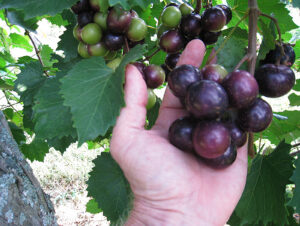
Muscadines now grow one USDA climate zone further north than they did 15-20 years ago. Photo: Guy K. Ames, NCAT
Most climate change models show a warming climate virtually everywhere, so growers considering changes are generally looking at cultivars or species that might currently or have recently been recommended for the USDA Plant Hardiness Zone to their immediate south. For instance, the author, Guy Ames, primarily a small-scale pear and apple orchardist in the upper South, thinks his apples are no longer commercially viable in the greater heat and drought of recent years. He is sticking with the pears but he is also experimenting with small numbers of figs, Persian mulberries, jujubes (Ziziphus jujuba), muscadine grapes, and Chinese melon trees (Cudrania tricuspidata). The muscadines, which officially are not cold-hardy enough for his climatic zone, have thrived for eight years and produced for six. The Persian mulberries were completely frozen out, the figs are killed back to the roots two years out of six, and the jujubes and melon trees are growing well but not yet bearing fruit. He is planting more muscadines. Ames hopes that soon universities will begin species and cultivar trials for climate change contingencies in a more orderly process.
Cornell University recommends “experimentation with new crops, varieties, and markets. Peaches, melons, tomatoes, and European red wine grapes are a few examples of longer growing season crops that will be favored by a warming climate” in New York (Wolfe, 2011).
Diversification necessarily involves its own costs and risks, but the idea is to avoid larger losses and larger risks. Yes, a new fruit relatively unknown to the general public carries the burden of added marketing costs, but if that new fruit succeeds when the old one falters, at least the farmer has something to market! For instance, jujubes have the potential to thrive in many of the arid areas of the country with little water, and they are flavorful and nutritious; nevertheless, they may prove difficult to market to people who have grown up on apples and peaches.
Grape growers in California are being forced to consider cultivar changes since “quality and yield of grapes depends on the interaction among soil, typography, and climate. As a result, high sensitivity to quality of grapes can affect wine prices. In a region where average wine grape prices can reach as much as $3,000 per ton, there is a lot at stake.” (Sparks, 2013).
In Oklahoma, Cooperative Extension no longer recommends raspberries (heat intolerant) and, instead, suggests heat- and drought-tolerant blackberry cultivars.
Water: Accommodating Flood and Drought

Newly installed cistern attached to farm building. Photo: Guy K. Ames, NCAT
The long-term droughts in California, the desert Southwest, and the Southern Plains are serious game changers if they continue, and most climate-change models predict they will. But even outside those areas, periodic droughts are becoming more common and farmers are considering appropriate responses.
Some responses to drought are obvious: more and deeper wells, cisterns, farm ponds, and more efficient irrigation. A tactic that is perhaps less obvious, to some, is building up organic matter in our soils to make them spongy and absorbent.
Permaculturists promote another, somewhat novel, approach to water conservation and that is the construction of swales. Swales are simply depressions in the earth, but the permaculture designer utilizes them to slow down the movement of water across a sloping landscape and allow it to percolate into the soil. Like increased organic matter in soils, swales are a bulwark against both drought and flood.
In hilly landscapes with varied aspects, southern and western exposures tend to be hotter and drier; eastern and northern aspects are cooler and moister. Making the most of these microclimate differences could be important to crop success in some cases.
Interest in collecting rain water from roofs has expanded from gardeners to large-scale farmers, who are attaching cisterns to their largest farm buildings. Sales of cisterns are booming, according to one California manufacturer whose company has a waiting list of anxious customers.
Flood Mitigation
Cornell University suggests the following for mitigating the effects of floods (2011):
- Increase soil organic matter for better drainage with practices such as reduced tillage, cover cropping, and use of composts or other organic amendments
- Invest in tile or other drainage systems for problem fields
- Shift to more flood-tolerant crops
- Buy or lease new acreage with better drainage
With regard to fruit and nut tolerance for flooding, almost everything in the genus Prunus (almonds, peaches, cherries, plums, and apricots) is subject to damage from saturated soils. Most grapes, raspberries, and apples are somewhat less sensitive but can’t tolerate flooded soils for long. Pears and blackberries are relatively tolerant of short-term flooding. Black walnuts and pecans can thrive in periodically flooded river bottoms.
Soil Building
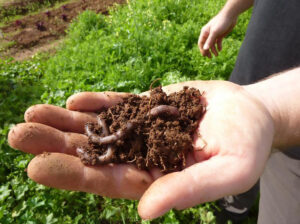
Good soil has lots of organic matter and earthworms. Photo: Rex Dufour, NCAT
Soil building has already been discussed above under the topic of water, but it bears repeating here: building the soil (increasing organic matter) is a protection from both drought and flood. A high-organic-matter soil is like a sponge, soaking up water and holding it in the soil reserve. “As you restore soil health you help agriculture adapt to climate change. As you help agriculture adapt to climate change you help improve water quality, improve wildlife and you help increase the fertility of the soil to potentially increase yields while at the same time helping to reduce the level of excess carbon dioxide in the atmosphere. This is clearly something we need to do,” said Clay Pope, the executive director of the Oklahoma Association of Conservation Districts (NSAC, 2014).
The perennial nature of fruit and nut crops provides an inherent soil-building advantage over annual crops: they don’t have to be plowed every year for planting (plowing generally degrades soil quality and accelerates the breakdown and loss of organic matter). Although some fruit and nut crops are cultivated for weed control, this practice is slowly disappearing (not unlike the soil that is lost from wind and water erosion on cultivated land). In place of conventional cultivation for weed control, orchardists are relying more on permanent cover crops, no-till, and/or mulches. These practices add organic matter back to the soil, especially relative to cultivation, which degrades soil organic matter.
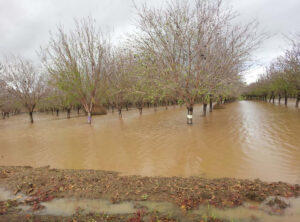
Without good soil management, flood water cannot percolate into soil. Photo: Rex Dufour, NCAT
In California, NCAT Agriculture Specialist Rex Dufour reports that organic walnut grower Russ Lester of Dixon Ridge Farms captured a 5-inches-in-24-hour rain without a drop leaving his land. After years of soil building, Lester’s spongy, well-aggregated soil soaked up all the rain, plus the rain that washed off his neighbors’ compacted land. Lester also said he was able to get harvest machinery back onto his land in half as much time (four to five days) as his neighbors. In addition to employing soil-building practices like cover cropping and compost applications, Lester makes biochar from his walnut shells and returns it to the land, presumably further increasing the water-holding capacity of his soil.
A high-organic-matter soil is also better at buffering temperatures (a less-dense medium does not readily conduct heat: think of bulky insulation materials for home building). So, soils with a high organic-matter content heat and cool more slowly, reducing plant stress.
Other benefits of building organic matter include providing fertility from the organic matter itself, improving fertilizer efficiency from added fertilizers (organic matter has a high cation exchange capacity; i.e., it chemically holds onto most fertilizer elements), and resisting erosion. A soil rich in organic matter teems with important soil life: both macro-organisms (like moles and worms) that help water percolate into soil and micro-organisms that are important parts of the soil food web, especially fungi that help with plant nutrition and disease resistance. All of these can benefit the crop in times of climatic stress.
A permanent organic mulch is often the choice of small-scale organic growers because it provides many soil-building and water-conserving benefits, but it might seem impractical from a commercial grower’s perspective. Recent research at the University of Arkansas comparing mulches in an organic apple study revealed that wood chips were superior to grass clippings and shredded newspaper (Rom, 2008) in terms of tree performance. Unlike other some other mulching materials, wood chips don’t appear to harbor rodents, and, more importantly for commercial growers, they can often be obtained for free and even delivered (at least in wooded parts of the country) by electric utility crews cleaning the right of way for power lines. Ramial wood chip mulch (made from branches less than seven centimeters in diameter) contains less lignified wood and more available nutrients, according to Quebec researchers, and soil fungi thrive in such a “woodsy” environment, providing long-term soil enrichment (Phillips, 2011).
Technology, Information, and Policy
Most farmers will adopt the best affordable technology to improve their farming. For instance, in Washington apple-growing districts, a common sight is an orchard glistening white in the full sun because trees and fruit have been sprayed with Surround ™, a pulverized kaolin clay product that reduces heat stress in the plants and inhibits sunburn on the fruit.
Another example of a technology in its infancy, but promising in times of climate change, is improved frost-prevention systems. Functioning together, on-farm weather stations linked in a network are better able to predict specific weather events like frosts. Michigan tart-cherry growers are in the process of building such a system (Rothwell et al., 2013) and Florida Department of Agriculture and Consumer Services has launched an aggregate weather data system (2013).
Irrigation technology, already relatively sophisticated in places like California, will become increasingly managed by field instruments and computers in order to make the very most of every drop. Look for open aqueducts and flood irrigation to become things of the past.
Presumably, technology will continue to provide protection for the nation’s soils. Otherwise, there is a real danger that cash-strapped farmers may see no alternative but turning back to primitive technologies, like wide-scale cultivation for weed control, that sacrifice organic matter—and the soil itself—to erosion.
As agricultural producers deal with increasingly challenging conditions, information, especially weather and climate information, will be in great demand. Most prognosticators predict that the future of agriculture will involve more and better computer-based information technologies to guide irrigation, planting, cultivar choices, etc. But there is a case to be made, if the permaculturists are right, that one of the best information sources is “more feet on the ground, more eyes on the land.” In other words, we need more farmers and more of those farmers talking to each other. Such farmer-to-farmer information exchanges could occur through the Internet or through something as simple as more farmers attending field days, farm tours, and networking events.
Public policy is important, and it’s possible that policy changes could lead to improvements. Recent changes to USDA crop-insurance programs, allowing for “whole farm” coverage instead of coverage for just individual crops, are a policy change that benefits farmers with diversified operations and specialty crops (Schahczenski, 2014). Examples of other useful policy changes that would help growers of perennial fruits and nuts include: 1) funding of plant exploration (e.g., variety trials) and breeding for cultivars better suited to the changing climate; 2) laws to better steward our limited water resources; 3) cooperative efforts to use “waste” products to improve the nation’s soils (e.g., municipal composting); and 4) public subsidies to help struggling farmers adopt best practices and tools for these challenging times. There are undoubtedly many more ideas that could help.
A hopeful sign from the federal government is the creation of USDA Climate Change Hubs, intended to “take decades of scientific research on natural resource disturbances related to weather and climate vulnerability, and convert those studies, data, and knowledge into practical management options for producers, forest owners and land managers” across the nation (McNulty, 2014).
Summary: Steps Fruit and Nut Growers Can Take to Increase Resiliency in the Face of Climate Change
Diversify
- Experiment with new cultivars and new species that seem to match a changing climate
- Try new marketing approaches that allow you to sell less-than-perfect fruit or nuts
- Diversify landscapes with swales, wildlife strips, ponds
Practice on-farm water stewardship
- Improve irrigation efficiency with latest technology
- Construct ponds and swales, dig wells, collect rain water
- Experiment with drought-tolerant crops
- Mulch
Invest in the soil to improve water permeability and retention
- Cover crop
- Mulch
- Avoid tillage for weed control
- Add compost
Adopt appropriate technology, ask for better information, demand policy changes
- Participate in linked weather-prediction systems
- Adopt most-efficient technology for irrigation and other farm operations
- Attend grower meetings and, together with other growers, ask for appropriate efforts from university researchers (e.g., breeding for heat tolerance and disease
- resistance)
- Demand that your political representatives address climate-change issues
- Support funding for agricultural research in regard to climate change
Conclusion
“If any group of farmers is to make it through the eye of the needle known as climate change, it will be the opportunistic, dynamic and resilient ones that invest in low-input, high diversity farming systems that offer value-added crops to nearby urban populations.” (Nabhan, 2013) Gary Nabhan, agroecologist and author of Growing Food in a Hotter, Drier Land, goes on to offer the advice to not neglect the past, and to look even to indigenous cultures for “new” ideas to meet the challenges of a changing climate.
All the suggestions made herein to prepare for a changing (probably warming) climate are good sustainable practices no matter the climate. Things like increasing soil organic matter, conserving water, and diversifying for risk management are important components of sustainable agriculture regardless of where the future takes us.
If anything characterizes climate change, it is uncertainty. That’s hard to plan for. Nevertheless, knowing that change is inevitable should inform us, at the least, to be poised to change. Of course, there are sophisticated computer models that provide likely scenarios based on available data, and we absolutely need to consider those. But Nabhan is probably right: we should be open-minded, opportunistic, ready to invest in policies and practices that make farming systems more resilient to stresses related to climate change.
Permaculture design. Note the mulch, species diversity, siting with the building for microclimate advantages, and guttering for rainwater collection. Photo: Andy Pressman, NCAT
Special Note on Permaculture
Permaculture design strives to integrate harmoniously all the diverse elements necessary to a thriving human community. Permaculture design is “a beneficial assembly of components in their proper relationships” (Mollison, 1991). The components include all the things discussed in this publication (water, soil, technology, food, information) and more, including ethics. Permaculture is not a recipe, but rather an integrated approach to living within a given bioregion, and the major thinkers (see for example Mollison, 1991 and Holmgren, 2002) are relatively uninterested in farming for profit, instead focusing on environmentally benign survival at what most of us would call a homesteading scale. In fact, scale itself is of critical importance to permaculturists. One of their principles is “use small and slow solutions” (Holmgren, 2002).
Presumably, permaculture operations will be buffered somewhat from climate change. All this may sound hopelessly and needlessly idealistic to people who have grown up in a time with a stable climate, abundant fossil-fuel energy, and apparently never-ending growth. Nevertheless, in times of change and uncertainty, the permaculturist’s embrace of diversity and understanding of integrating diverse elements into a single system may provide a model of environmental sustainability for us all.
References
Anon. 2011. Climate change to deal blow to fruits, nuts: study. The Independent. June 5.
Cornell University College of Agriculture and Life Sciences. 2011. Climate Change Facts.
Dufour, Rex. 2014. Regional Office Director. NCAT Western Regional Office, Davis, California. Personal communication.
Ewing, Jim. 2014. Outreach Coordinator. NCAT Gulf States Regional Office, Jackson, Mississippi. Personal communication.
Fitchett, Jennifer M., Stefan W. Grab, Dave I. Thompson, and Gholamreza Roshan. 2014. Increasing frost risk associated with advanced citrus flowering dates in Kerman and Shiraz, Iran: 1960–2010. International Journal of Biometeorology.
Florida Department of Agriculture and Consumer Services. 2013. New “My Florida Farm Weather” App Gives Agricultural Producers Real-Time Data on Temperature, Rainfall, Wind, More.
Garcia-Salazar, Carlos. 2012. Climate Change Impacts Michigan Blueberry Industry. Michigan State University Extension.
Holmgren, David. 2002. Permaculture: Principles & Pathways Beyond Sustainability. Holmgren Design Services, Hepburn, Australia. p. 129.
Luedeling,E., E.H. Girvetz, M.A. Semenov, and P.H. Brown. 2011. Climatic changes lead to declining winter chill during 1950-2099. PLoS One. Vol. 6. No. 5. e20155.
McNulty, Steve. 2014. Southeast Regional Climate Hub Works to Sustain Agricultural and Forest Systems.
Mollison, Bill. 1991. Introduction to Permaculture. Tagari Publications, Tyalgum, Australia.
Myrow, Rachael. 2014. Light California Cherry Season Thanks to Warm Winter—Expect Higher Prices. KQED Radio: Bay Area Bites. May 13.
Nabhan, Gary. 2014. Innovative Farming in the Face of Climate Uncertainty. National Young Farmers Coalition. May 14.
NSAC. 2014. Senate Subcommittee Hearing Examines the Impacts of Climate Change on Agriculture.
Phillips, Michael. 2011. The Holistic Orchard. Chelsea Green Publishing Co., White River Junction, VT. p. 8.
Philpott, Tom. 2014. Will California’s drought bring about $7 broccoli? Mother Jones. May/June.
Pope, Clay. 2014. Testimony before the U.S. Senate Subcommittee hearing “Farming, Fishing, Forestry, and Hunting in an Era of Changing Climate.” June 3.
Pressman, Andy. NCAT Program Specialist, New Hampshire. Personal communication, 2014.
Rom, Curt. Department of Horticulture, University of Arkansas. Personal communication, 2014.
Rom, C.R., J. McAfee , H. Friedrich, H. Choi, M. E. Garcia, D.T. Johnson, J. Popp and M. Savin. 2008. Early performance during establishment of an organic apple orchard in the upper mid-south. HortScience. Vol. 43 No. 4 p. 609 (abstract).
Rothwell, N., M. Woods, and P. Korson, 2013. Assessing and Communicating Risks from Climate Variability for the Michigan Tart Cherry Industry. P. 1-7..In: D. Brown, D. Bidwell, and L. Briley (eds.). Project Reports. Great Lakes Integrated Sciences and Assessments (GLISA) Center, Ann Arbor, MI.
Roy, Sujoy B., Limin Chen, Evan Girvetz, Edwin P. Maurer, William B. Mills, and Thomas M. Grieb. 2012. Projecting Water Withdrawal and Supply for Future Decades in the U.S. under Climate Change Scenarios Environmental Science & Technology. Vol. 46 , No.5. p. 2545–2556.
Schahczenski, Jeff. 2014. NCAT Program Specialist, Butte, Montana. Personal communication.
Sparks, Brian. 2013. Climate change: the new normal in fruit growing. Growing Produce. June 3.
U.S. Environmental Protection Agency. 2013. Climate Impacts in the Southeast.
USDA. California Almond Acreage Report. 2013.
Winkler, J.A., G.S. Guentchev, P. Perdinan, N. Tan, S. Zhong, M. Liszewska, Z. Abraham, T. Niedźwiedź, and Z. Ustrnul. 2011. Climate scenario development and applications for local/regional climate change impact assessments: An overview for the non-climate scientist. Part I: Scenario development using downscaling methods. Geography Compass. Vol. 5/6. p. 275–300.
Wolfe, David. 2011. Climate Change Facts: Farming Success in an Uncertain Climate.
Climate Change and Perennial Fruit and Nut Production: Investing in Resilience in Uncertain Times
By Guy K. Ames and Rex Dufour, NCAT Agriculture
Specialists
Published October 2014
©NCAT
IP476
Slot 488
Version 100914
This publication is produced by the National Center for Appropriate Technology through the ATTRA Sustainable Agriculture program, under a cooperative agreement with USDA Rural Development. ATTRA.NCAT.ORG

